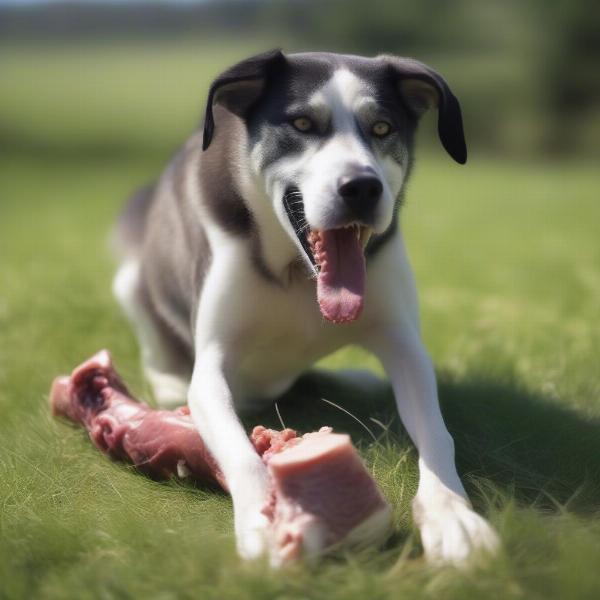Bone marrow is a popular treat for dogs, offering a rich source of flavor and nutrients. However, feeding bone marrow to your dog comes with potential benefits and risks that every owner should understand before offering this tasty morsel. This article will delve into the nutritional value of bone marrow, the potential hazards, and how to safely incorporate it into your dog’s diet.
The Nutritional Benefits of Bone Marrow for Dogs
Bone marrow is packed with essential nutrients, making it a potentially valuable addition to a balanced canine diet. It’s a rich source of healthy fats, providing vital fatty acids like omega-3 and omega-6, which contribute to healthy skin and coat. Additionally, bone marrow is a good source of iron, supporting healthy red blood cell production, and contains minerals like calcium and phosphorus, crucial for strong bones and teeth. It’s also a natural source of glucosamine and chondroitin, which can support joint health, especially beneficial for older dogs or those prone to arthritis.
Potential Hazards of Feeding Bone Marrow to Dogs
While bone marrow offers nutritional benefits, certain risks are associated with feeding it to your dog. The primary concern is the potential for splintering of the bone, especially cooked bones. Sharp bone fragments can cause choking, internal injuries, or blockages in the digestive tract. Furthermore, excessive fat intake from bone marrow can lead to pancreatitis, a serious and potentially life-threatening inflammation of the pancreas. Raw bone marrow also carries the risk of bacterial contamination, such as Salmonella or E. coli, which can cause illness in both dogs and humans.
Safely Incorporating Bone Marrow into Your Dog’s Diet
If you choose to give your dog bone marrow, it’s crucial to do so safely. Always opt for raw, fresh marrow bones for dogs from reputable butchers. Never feed cooked bones, as they are much more likely to splinter. Supervise your dog closely while they are enjoying the marrow and remove the bone once they’ve extracted most of the marrow or if it starts to splinter.
 Dog chewing on a large marrow bone
Dog chewing on a large marrow bone
Consider offering bone marrow treats for dogs that are specifically designed for safe consumption. These treats are often made from softer bones or have the marrow extracted and formed into a safer, chewable format. Remember that moderation is key. Bone marrow should be given as an occasional treat, not a regular part of your dog’s diet. Consult your veterinarian to determine the appropriate amount of bone marrow for your dog’s size, breed, and overall health.
Choosing the Best Marrow Bones for Dogs
Choosing appropriate marrow bones is essential for your dog’s safety. Large, raw beef femur bones are generally a good choice, providing plenty of marrow without splintering easily. Avoid smaller bones, weight-bearing bones, or bones that have been sawed or cut, as these pose a higher risk of splintering. You can also find raw bone marrow for dogs pre-packaged and frozen at some specialty pet stores.
How to Cook Marrow Bones for Dogs (Safely)? – Do Not Cook Bones!
It’s crucial to emphasize that you should never cook bones for your dog. Cooking makes bones brittle and prone to splintering, creating a serious choking hazard. If you want to soften the marrow for easier consumption, especially for senior dogs, consider lightly thawing frozen raw bones or scraping out the raw marrow and mixing it with their regular food. Learn more about how to cook marrow bones for dogs – remember, it involves not cooking them.
Conclusion
Bone marrow can be a healthy and enjoyable treat for your dog, providing valuable nutrients and satisfying their natural chewing instincts. However, it’s crucial to understand the potential risks and take necessary precautions to ensure safe consumption. By following the guidelines outlined in this article, you can offer this delicious treat while minimizing the chances of injury or illness.
FAQ
-
Is bone marrow good for puppies? While bone marrow offers beneficial nutrients, it’s generally best to avoid giving it to puppies due to the increased risk of choking or digestive issues.
-
Can dogs eat cooked bone marrow? Never give cooked bones to dogs, including cooked bone marrow. Cooked bones are brittle and easily splinter, posing a serious choking hazard.
-
How often can I give my dog bone marrow? Bone marrow should be an occasional treat, not a regular part of your dog’s diet. Consult your veterinarian for guidance on frequency and portion size.
-
What are the signs of bone marrow allergy in dogs? Allergic reactions to bone marrow are rare, but signs may include vomiting, diarrhea, skin rashes, or facial swelling. Contact your veterinarian immediately if you observe any of these symptoms.
-
What are good alternatives to bone marrow for dogs? Safe alternatives to bone marrow include dental chews, bully sticks, or frozen carrots.
-
Can I give my dog chicken bone marrow? Avoid giving chicken bones to dogs, as they are small and splinter easily. Stick to larger beef or lamb bones.
-
What should I do if my dog swallows a bone splinter? If your dog swallows a bone splinter, contact your veterinarian immediately. Do not attempt to induce vomiting.
ILM Dog is your trusted resource for expert advice and practical tips on all aspects of dog care, from breed selection and nutrition to training and health. We offer a wealth of information to help you provide the best possible care for your canine companion. Whether you’re a seasoned dog owner or just starting your journey, ILM Dog is here to support you every step of the way. Contact us at [email protected] or +44 20-3965-8624 for personalized guidance.